|
HOUSE-SOILING (FELINE)

WHEN GOOD CATS DO BAD THINGS
Tips on Feline House-Soiling
|
|
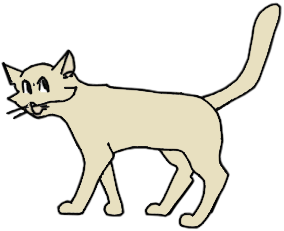
(original graphic by marvistavet.com)
|

(original graphic by marvistavet.com)
|
|
Despite the cat’s reputation for fastidious cleanliness, house-soiling is the number one behavior problem of our feline friends. Many cats are turned outside, given away, or even put to sleep for this behavior problem, and it behooves the veterinary profession to address it.
Urinating in odd places can mean a medical problem, a territorial marking problem, or some sort of social or environmental problem and sometimes the differences are not clear cut. Several factors may be in play and some conditions involve medical symptoms resulting from psychological stress. In other words, a combination of medical and behavior issues may be at work.
SHOULD THE APPROACH BE MEDICAL?
|
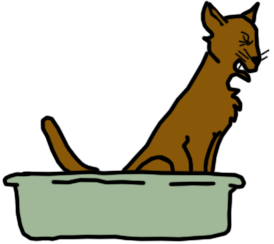
(original graphic by marvistavet.com)
|
There are several medical conditions that can lead a cat to inappropriate urination and these should be ruled out so as not to get on the wrong track. The cat will need to be examined and some testing. Conditions to rule out in part depend on the age of the cat as young adult cats tend to get different diseases than do senior cats but, briefly, here are some conditions that should be checked out:
- Bladder infection (very common in senior cats, very unusual in young adult cats but still needs to be ruled out).
- Bladder stone (more common in female cats, than in male cats but can happen to any cat).
- Conditions that lead to excessive water consumption (there are probably a dozen such conditions and they are all more common in older cats versus younger cats but most are ruled out with a basic blood panel).
- Arthritis (usually an older cat's problem. Often these cats will urinate next to the box or near it because they cannot squat properly or cannot step into a high-walled box).
- Bladder tumor (not common but still a consideration in older cats especially if there is straining to urinate and/or bloody urine).
- Constipation frequently leads to the cat passing stool in any number of places and is generally characterized by straining to defecate and small very hard stools.
|
Of special note is the condition currently referred to as "Feline Idiopathic Cystitis." This conditions amounts to a physical manifestations of anxiety where the cat not only may urinate inappropriately but also strains painfully in the litter box, and produces bloody urine. A male cat can actually obstruct his urinary tract, creating a medical emergency. This is a common condition in young adult cats but is uncommon in older cats. Please see the link above for more details on this complex condition.
As mentioned, Your veterinarian should evaluate your cat medically before you conclude that the problem is behavioral and you embark on a long-term behavioral approach.
URINE MARKING / TERRITORIAL ANXIETY
Cats use urination and defecation as a means of communication with other cats. By leaving their mark, they are telling other cats “I was here on this date at this time.” Other cats may then know this land has been claimed (or has not been recently claimed) and may act accordingly. Cats also mark by rubbing their faces on objects and by scratching vertically on surfaces. Psychological stress, such as the presence of other cats, moving to a new home, prolonged or sudden absence of the owner (who is usually viewed as a parent by the pet cat), noisy construction outside, visiting humans or other animals, or even new furniture may create a need for a cat to reassert a territorial claim. Signs that this kind of stress is causing the problem might include some or all of the following:
- Spraying on an upright surface.
- Urinating in the litter box sometimes and sometimes urinating elsewhere (as opposed to never using the box at all).
- Defecating in the cat box but urinating outside the box.
- The cat (either male or female) is not neutered.
- There has been a change at home leading the cat to feel he/she must reassert his/her territorial boundaries. (Examples: a new pet has been added, a new roommate has been added, a recent move to a new home has occurred, remodeling has been done, the owner recently returned from a vacation, other neighborhood cats are visible or smellable in the yard.)
- The area marked is near a door or window.
- The problem did not start until new furniture was added or the furniture was rearranged.
- The cat appears to be responding to a punishment for another behavior.
- The area marked involves the owner’s bed or laundry.
- The area marked is the same each time.
If any of these scenarios seem to fit, anti-anxiety medications may be tremendously helpful if the source of stress cannot be identified or cannot be altered.
Medications commonly used as anti-anxiety treatments for inappropriate urination include:
CLOMIPRAMINE®
This medication has been helpful in the treatment of obsessive-compulsive disease and depression in humans and has been approved for canine separation anxiety. It has come to be the first choice of many behaviorists for urine marking cats. In one study 80% of cats showed at least a 75% reduction in episodes of inappropriate urination within 4 weeks.
FLUOXETINE
This medication is more commonly known as Prozac®. It has been used for feline urine marking and has been found of comparable efficacy to clomipramine. At least 8 weeks of treatment was required to achieve results in over 90% of cats and as long as they took the medication, they did not mark. If the medication is discontinued, marking may resume but is just as likely to respond a second time if the initial treatment was successful.
BUSPAR®
This medication acts by blocking the effect of serotonin (a brain chemical). Studies have found this medication to be approximately 75% effective in reducing inappropriate urination in about half the cats that used it. It is typically given orally twice a day for a 2-week period. If it seems to work, the course is continued for a total of 8 weeks. After this period, it may be discontinued. Approximately half the cats in whom it is used do not resume inappropriate urination. The other half re-develop the problem and must continue on Buspar.
A WORD ON FEMALE HORMONE TREATMENTS
In the past, female hormones (common brand names: Megace, Ovaban, and depoprovera) have been used to control inappropriate urination. These treatments have not shown as wide success as the newer medications listed above plus they have been fraught with serious side effect potential (mammary cancer and/or induction of diabetes mellitus). We recommend that these hormones be used only as an alternative to euthanasia.
OTHER PRODUCTS FOR ANXIETY
Several other products that help with anxiety are noteworthy, especially in situations where a cat is not amenable to taking medication or there is a medical condition that precludes medication.
DIETARY SUPPLEMENTS
Alpha-casozepine is a natural protein contained in milk and is responsible for the calming features of drinking warm milk. It is available in pill form and it has also been formulated into calming diets. It is not particularly sedating but has anti-anxiety properties helpful in creating a more "zen" brain-chemistry. L-theonine is derived from green tea leaves and is available in tablet form for dogs and cats also for anxiety management. Supplements such as these are compatible with the other therapies listed above so they may be used in combination with pheromones or with medications. |
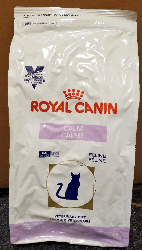 (original graphic by marvistavet.com) (original graphic by marvistavet.com) |
PHEROMONE SPRAYS AND DEFUSERS
Feliway® spray is a spray for the area being marked rather than a medication administered to the cat. The spray consists of feline pheromones of the type that cats deposit when performing facial marking (i.e., rubbing their face/cheeks on things to scent mark). These pheromones provide a message in the cat's own language proclaiming that the territory is secure and there is nothing to worry about. This confers a general calming effect and reduces the cat's interest in marking. Feliway is available as a spray to apply to marking surfaces or as a plug-in deffuser that spreads pheromones through the room. Defusers last approximately one month.
|
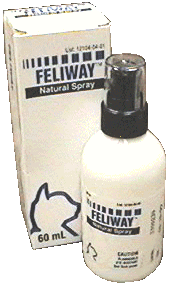
|
|
A study was conducted when pheromone therapy was new. Fifty-seven households with urine spraying cats were involved. These cats marked on either vertical surfaces only or a combination of vertical and horizontal surfaces. Feliway spray was used twice a day on the urine marked areas for a one month period. In one-third of households, urine marking stopped completely. In 57% of the households, urine marking was reduced and in 9.3% of households marking was unchanged.
Hunthausen, W.
Evaluating a feline facial pheromone analogue to control urine spraying.
Veterinary Medicine, Feb 2000, p 151 - 155
|
|
IT IS IMPORTANT TO NOTE THAT NEUTERING
IS THE FIRST STEP IN ADDRESSING THIS PROBLEM.
HORMONAL MOTIVATIONS TO MARK TERRITORY
ARE POTENT AND MUST BE REMOVED FROM THE PICTURE.
LITTER BOX AVERSION/ENVIRONMENTAL FACTORS
Another reason why cats urinate or defecate outside the box is simply that the box is not acceptable to them. The box may be dirty, may not be adequately private, may smell funny or be uncomfortable. The following are clues that an inappropriate urination problem reflects litter box aversion:
- Urination does not involve spraying vertical surfaces.
- Both urination and defecation occur outside the litter box.
- Two or more cats share a litter box (the current litter box recommendation is one box per cat plus one extra).
- A new brand of litter is suddenly being used.
- The box is covered. (A covered bathroom area is highly unnatural for cats as they prefer better lighting for elimination and odors are concentrated in an enclosed area such as a covered box.)
- The box is not changed frequently.
- The cat has had a negative experience in the box (the cat was captured from the box to receive medication or be disciplined).
- The litter box is in a heavy household traffic area or where there are noisy appliances.
- A puppy or dog (or even a small child) is bothering the cat in the box.
- The litter box is located near a noisy appliance (such as a clothes dryer).
- Another cat in the household is a bully and/ or controls access to resources such as food, rest areas or the litter box in a multi-cat household.
Cats with litter box aversion frequently require re-training to the box. As a first step, the litter box situation must be made optimal as best as possible. If it is possible, an additional box should be provided. If there are multiple floors to the home, there should be a box on each level. The box should be 1.5 times the length of the cat (not including the tail) or the cat will feel cramped. If possible, the boxes should not be in the same location in the house so that the cat feels a sense of privacy and is not confronted by other cats who "need the bathroom."
The box should not be in a high traffic area. In a single cat home, the cat may have experienced something unpleasant in association with the current litter box (molestation by a child or dog, loud noise etc.) and needs a new "bathroom area." It is important not to keep the cat’s food in a location near the box as the cat will not want to use the feeding area as a toilet.
|
Obviously, any litter boxes should be scooped daily or even twice daily and kept as clean as possible. Clumping litter should be changed at least monthly and non-clumping litter should be changed twice weekly. The box should be washed with soapy water or water alone with no strong-smelling disinfectants that might be objectionable to the cat.
We have had good experience with a litter additive called “Cat Attract” which is an herbal product designed to return the cat to the box. We recommend including this product in the regimen. If the problem is difficulty in keeping the box clean, a self-cleaning box may be helpful. On the other hand, some cats object to the moving parts so use your judgment.
|
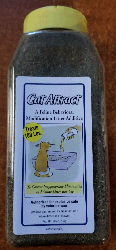
(original graphic by marvistavet.com)
|
As the next step, some other type of litter can be provided to see if the cat prefers a different brand or type. (Signs that the cat does not like the litter include: sitting on the plastic lip of the litter box to eliminate, failure to dig a hole in the litter, and/or shaking the litter off the paws after exiting the box.) If nothing seems to work, the cat should be confined in a small area, such as a large plastic carrier, with a litter box. The cat is gradually allowed more area after he/she has proven that he will use the box. (First, the carrier is the housing area, then a small room such as a bathroom or playpen is allowed, next a large room is added etc. until the cat again has his usual access.) Alternatively, the cat may be boarded in an animal hospital as housing in a small cage commonly brings the cat back to the litter box plus the cat can be observed for other problems that might be contributing to the elimination problem.
|
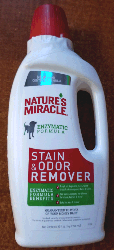
(original graphic by marvistavet.com)
ilovenaturesmiracle.com
|
ODOR ELMINATORS
SHOULD BE USED IN MARKED AREAS
TO DISCOURAGE THE CAT’S TENDENCY
TO RETURN TO THESE AREAS. |
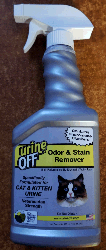
(original graphic by marvistavet.com)
urineoff.com
|
MANY PEOPLE WASTE TIME AND EFFORT ON THE WRONG APPROACH
UNTIL THEY ARE AT THEIR WIT'S END AND ARE CONSIDERING EUTHANASIA.
IF YOUR CAT OCCASIONALLY ELIMINATES INAPPROPRIATELY, PLEASE INFORM YOUR VET PROMPTLY.
If these tips are not effective in restoring the cat’s proper toilet behaviors, a behavior specialist should be called in. Please contact your veterinarian for the best consultant in your area.

Page last updated: 10/13/2025
|